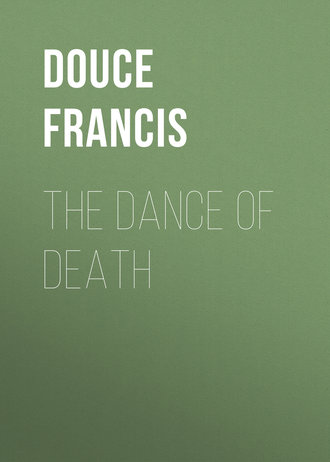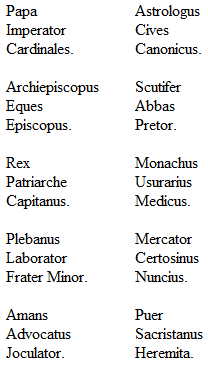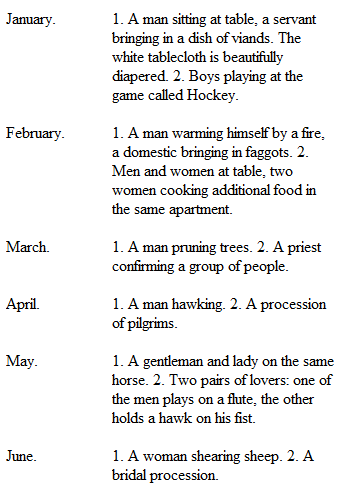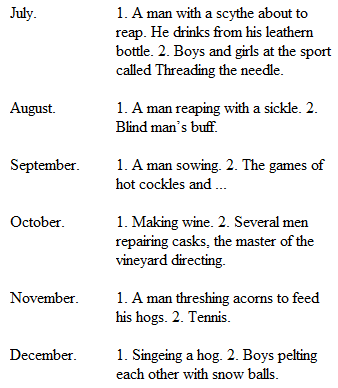 полная версия
полная версияПолная версия
The Dance of Death
25. “La grande Danse Macabre des hommes et des femmes, &c. Troyes, Oudot,” 1641, 4to. cuts. One of the bibliothèque bleue books.
26. “La grande Danse Macabre des hommes et des femmes, renouvellée de vieux Gaulois en langage le plus poli de notre temps, &c. Troyes, Pierre Garnier rue du Temple.” No date, but the privilege is in 1728, 4to. cuts. The polished language is, of course, for the worse, and Macaber is called “des Machabées,” no doubt, the editor’s improvement.
27. “La grande Danse Macabre des hommes et des femmes, renouvellée, &c. Troyes, chez la veuve Oudot, et Jean Oudot fils, rue du Temple, 1729,” 4to. cuts. Nearly the same as No. 25.
These inferior editions continued, till very lately, to be occasionally reprinted for the use of the common people, and at the trifling expense of a very few sous. They are, nevertheless, of some value to those who feel interested in the subject, as containing tolerable copies of all the fine cuts in the preceding edition, No. 11.
Dr. Dibdin saw in the public library at Munich a very old series of a Macaber Dance, that had been inserted, by way of illustration, into a German manuscript of the Dance of Death. Of these he has given two subjects in his “Bibliographical Tour,” vol. iii. p. 278.
But it was not only in the above volumes that the very popular subject of the Macaber Dance was particularly exhibited. It found its way into many of the beautiful service books, usually denominated Horæ, or hours of the Virgin. These principally belong to France, and their margins are frequently decorated with the above Dance, with occasional variety of design. In most of them Death is accompanied with a single figure only, characters from both sexes being introduced. It would be impossible to furnish a complete list of them; but it is presumed that the mention of several, and of the printers who introduced them, will not be unacceptable.
No. I. “Las Horas de nuestra Senora con muchos otros oficios y oraçiones.” Printed in Paris by Nicolas Higman for Simon Vostre, 1495, 8vo. It has two Dances of Death, the first of which is the usual Macaber Dance, with the following figures: “Le Pape, l’Empereur, le Cardinal, l’Archevesque, le Chevalier, l’Evesque, l’Escuyer, l’Abè, le Prevost, le Roy, le Patriarche, le Connestable, l’Astrologien, le Bourgoys, le Chanoine, le Moyne, l’Usurier, le Medesin, l’Amoureux, l’Advocat, le Menestrier, le Marchant, le Chartreux, le Sergent, le Cure, le Laboureur, le Cordelier.” Then the women: “La Royne, la Duchesse, la Regente, la Chevaliere, l’Abbesse, la Femme descine, la Prieure, la Damoissele, la Bourgoise, la Cordeliere, la Femme daceul, la Nourice, la Theologienne, la nouvelle mariee, la Femme grosse, la Veufve, la Marchande, la Ballive, la Chamberiere, la Recommanderese, la vielle Damoise, l’Espousée, la Mignote, la Fille pucelle, la Garde d’accouchée, la jeune fille, la Religieuse, la Vielle, la Revenderesse, l’Amoureuse, la Sorciere, la Bigote, la Sote, la Bergere, la Femme aux Potences, la Femme de Village; to which are added, l’Enfant, le Clerc, l’Ermite.”
The second Dance of Death is very different from the preceding, and consists of groupes of figures. The subjects, which have never yet been described, are the following:
1. Death sitting on a coffin in a church-yard. “Discite vos choream cuncti qui cernitis istam.”
2. Death with Adam and Eve in Paradise. He draws Adam towards him. “Quid tum prosit honor glorie divitie.”
3. Death helping Cain to slay Abel. “Esto meorum qui pulvis eris et vermibus esca.”
4. Death holding by the garment a cardinal, followed by several persons. “In gelida putrens quando jacebis humo.”
5. Death mounted on a bull strikes three persons with his dart. “Vado mori dives auro vel copia rerum.”
6. Death seizing a man sitting at a table with a purse in his hand, and accompanied by two other persons. “Nullum respectum dat michi, vado mori.”
7. An armed knight killing an unarmed man, Death assisting. “Fortium virorum est magis mortem contemnere vitam odisse.”
8. Death with a rod in his hand, standing upon a groupe of dead persons. “Stultum est timere quod vitari non potest.”
9. Death with a scythe, having mowed down several persons lying on the ground. “Est commune mori mors nulli parcit honori.”
10. A soldier introducing a woman to another man, who holds a scythe in his hand. Death stands behind. “Mors fera mors nequam mors nulli parcit et equam.”
11. Death strikes with his dart a prostrate female, who is attended by two others. “Hec tua vita brevis: que te delectat ubique.”
12. A man falling from a tower into the water. Death strikes him at the same time with his dart. “Est velut aura levis te mors expectat ubique.”
13. A man strangling another, Death assisting. “Vita quid est hominis nisi res vallata ruinis.”
14. A man at the gallows, Death standing by. “Est caro nostra cinis modo principium modo finis.”
15. A man about to be beheaded, Death assisting. “Quid sublime genus quid opes quid gloria prestant.”
16. A king attended by several persons is struck by Death with his dart. “Quid mihi nunc aderant hec mihi nunc abeunt.”
17. Two soldiers armed with battle-axes. Death pierces one of them with his dart. “Ortus cuncta suos: repetunt matremque requirunt.”
18. Death strikes with his dart a woman lying in bed. “Et redit in nihilum quod fuit ante nihil.”
19. Death aims his dart at a sleeping child in a cradle, two other figures attending. “A, a, a, vado mori, nil valet ipsa juventus.”
20. A man on the ground in a fit, Death seizes him. Others attending. “Mors scita sed dubia nec fugienda venit.”
21. Death leads a man, followed by others. “Non sum securus hodie vel cras moriturus.”
22. Death interrupts a man and woman at their meal. “Intus sive foris est plurima causa timoris.”
23. Death demolishes a group of minstrels, from one of whom he has taken a lute. “Viximus gaudentes, nunc morimur tristes et flentes.”
24. Death leads a hermit, followed by other persons. “Forte dies hec est ultima, vado mori.”
This Dance is also found in the Horæ printed by Godar, Vostre, and Gilles Hardouyn, but with occasional variations, as to size and other matters, in the different blocks which they respectively used. The same designs have also been adopted, and in a very singular style of engraving, in a work printed by Antony Verard, that will be noticed elsewhere.
Some of the cuts, for they are not all by the same artist, in this very rare and beautiful volume, and not found in others printed by or for Simon Vostre, may be very justly compared, in point of the delicacy of design and engraving, though on wood, with the celebrated pax of Maso Finiguerra at Florence, accurately copied in Mr. Ottley’s history of engraving. They are accompanied with this unappropriated mark

No. II. “Ordinarium beate Marie Virginis ad usum Cisterciensem impressum est caracteribus optimis una cum expensis honesti viri Symonis Vostre commorantis Parisiis in vico novo Dive Marie in intersignio Sancti Joannis Evangeliste, 1497,” 12mo. This beautiful book is on vellum, with the same Danse Macabre as in the preceding, but the other cuts are different.
No. III. “Hore presentes ad usum Sarum impresse fuerunt Parisiis per Philippum Pigouchet Anno Salutis MCCCCXCVIII die vero xvi Maii pro Symone Vostre librario commorante, &c.” 8vo. as above.
Another beautiful volume on vellum, with the same Danse Macabre. He printed a similar volume of the same date, for the use of Rome, also on vellum.
A volume of prayers, in 8vo. mentioned by M. Peignot, p. 145, after M. Raymond, but the title is not given. It is supposed to be anterior to 1500, and seems to contain the same personages in its Danse Macabre, as in the preceding volumes printed by Simon Vostre.
No. IV. “Heures à l’usage de Soissons.” Printed by Simon Vostre, on vellum, 1502, 8vo. With the same Danse Macabre.
No. V. “Heures à l’usage de Rheims, nouvellement imprimées avec belles histoires, pour Simon Vostre,” 1502, 8vo. This is mentioned by M. Peignot, on the authority of Papillon. It was reprinted 1513, 8vo. and has the same cuts as above.
No. VI. “Heures à l’usage de Rome. Printed for Simon Vostre by Phil. Pigouchet,” 1502, large 8vo. on vellum. With the same Danse Macabre. This truly magnificent volume, superior to all the preceding by the same printer in beauty of type and marginal decoration, differs from them in having stanzas at the bottom of each page of the Dance, but which apply to the figure at the top only. They are here given.
PopeVous qui vivez certainementQuoy qu’il tarde ainsi danserezMais quand Dieu le scet seulementAvisez comme vous ferezDam Pape vous commencerezComme le plus digne SeigneurEn ce point honorire serezAu grant maistre est deu l’honneur.KingMais maintenant toute haultesseLaisserez vous nestes pas seulPeu aurez de votre richesseLe plus riche n’a qung linseulVenez noble Roy couronneRenomme de force et prouesseJadis fustez environneDe grans pompes de grant noblesse.ArchbishopQue vous tirez la teste arriereArchevesque tirez vous près,Avez vous peur qu’on ne vous fiereNe doubtez vous viendres aprèsN’est pas tousjours la mort empresTout homme suyvant coste a costeRendre comment debtez et presUne foys fault coustera loste.SquireIl n’est rien que ne preigne coursDansez et pensez de suyrVous ne povez avoir secoursIl n’est qui mort puisse fuyrAvencez vous gent escuyerQui scavez de danser les toursLance porties et escuz hyerAujourdhuy finerez voz jours.AstrologerMaistre pour vostre regarderEn hault ne pour vostre clergieNe pouvez la mort retarderCi ne vault rien astrologieToute la genealogieD’Adam qui fust le premier hommeMort prent se dit theologieTous fault mourir pour une pomme.MerchantVecy vostre dernier marcheIl convient que par cy passezDe tout soing serez despechieTel convoiste qui a assezMarchant regardes par decaPlusieurs pays avez cerchieA pied a cheval de piecaVous n’en serez plus empeschie.MonkHa maistre par la passeresN’est ja besoing de vous defendrePlus homme nespouvanteresApres Moyne sans plus attendreOu pensez vous cy fault entendreTantost aurez la bouche closeHomme n’est fors que vent et cendreVie donc est moult peu de chose.LoverTrop lavez ayme cest foleurEt a mourir peu regardeTantost vous changerez couleurBeaulte n’est que ymage fardeGentil amoureux gent et friqueQui vous cuidez de grant valeurVous estez pris la mort vous piqueCe monde lairez a douleur.CuratePassez cure sans long songierJe sans questes habandonneLe vif le mort soulier mengerMais vous serez aux vers donneVous fustes jadis ordonneMiroir dautruy et exemplaireDe voz faitz serez guerdonneA toute peine est deu salaire.ChildSur tout du jour de la naissanceConvient chascun a mort offrirFol est qui n’en a congnoissanceQui plus vit plus a assouffrirPetit enfant naguerez neAu monde aures peu de plaisanceA la danse sera meneComme autre car mort a puissance.QueenNoble Royne de beau corsageGente et joyeuse a ladvenantJay de par le grant maistre chargeDe vous enmener maintenantEt comme bien chose advenantCeste danse commenseresFaictes devoir au remenantVous qui vivez ainsi feres.LadyC’est bien chasse quand on pourchasseChose a son ame meritoireCar au derrain mort tout enchasseCeste vie est moult transitoireGentille femme de chevalierQue tant aymes deduit et chasseLes engins vous fault habillerEt suyvre le train de ma trasse.PrioressSe vous avez sans fictionTout vostre temps servi à DieuDu cueur en sa religionLa quelle vous avez vestueCeluy qui tous biens retribueVous recompenserer loyalmentA son vouloir en temps et lieuBien fait requiert bon payment.Franciscan nunSe vos prieres sont bien dignesElles vous vauldront devant DieuRien ne vallent soupirs ne signesBone operacion tient lieuFemme de grande devocionCloez voz heures et matinesEt cessez contemplacionCar jamais nyres a matines.Chamber-maidDictez jeune femme a la crucheRenommée bonne chambriereRespondez au moins quant on hucheSans tenir si rude maniereVous nirez plus a la riviereBaver au four na la fenestreCest cy vostre journee derniereAusy tost meurt servant que maistre.WidowCest belle chose de tenirLestat ou on est appelleeEt soy tousjours bien maintenirVertus est tout par tout louee.Femme vesve venez avantEt vous avancez de venirVous veez les aultres davantIl convient une fois finir.Lying-in nurseVenez ca garde dacoucheesDresse aves maintz bainz perdusEt ses cortines attacheesOu estoient beaux boucques pendusBiens y ont estez despendusTant de motz ditz que cest ung songeQui seront cher vendusEn la fin tout mal vient en ronge.ShepherdessAux camps ni rez plus soir ne matinVeiller brebis ne garder bestesRien ne sera de vous demainApres les veilles sont les festesPas ne vous oublieray derriereVenez apres moy sa la mainEntendez plaisante bergiereOu marcande cy main a main.Old womanEt vous madame la gourreeVendu avez maintz surplisDonc de largent est fourreeEt en sont voz coffres remplisApres tous souhaitz acomplisConvient tout laisser et ballierSelon la robe on fait le plisA tel potaige tel cuiller.WitchEst condannee comme meurtriereA mourir ne vivra plus gaireJe la maine en son cimitiereCest belle chose de bien faireOyez oyez on vous fait scavoirQue ceste vielle sorciereA fait mourir et decepvoirPlusieurs gens en mainte maniere.In the cut of the adoration of the shepherds their names are introduced as follows: Gobin le gay; le beau Roger; Aloris; Ysauber; Alison, and Mahault. The same cut is in two or three other Horæ mentioned in this list.
No. VII. “Heures à l’usaige de Rouan. Simon Vostre, 1508, 8vo.” With the same Danse Macabre.
No. VIII. “Horæ ad usum Romanum. Thielman Kerver,” 1508, 8vo. Vellum. With the same Danse Macabre.
No. IX. “Hore christofere virginis Marie secundum usum Romanum ad longum absque aliquo recursu, &c.” Parisiis. Simon Vostre, 1508, 8vo. M. Peignot has given a very minute description of this volume with a list of the different persons in the Danse Macabre.
No. X. “Heures à l’usage de … Ant. Verard,” 1509, 8vo. with the same Danse Macabre.
No. XI. “Heures à l’usaige d’Angers. Simon Vostre,” 1510, 8vo. With the same Danse Macabre. Particularly described by M. Peignot.
No. XII. “Heures à l’usaige de Rome. Guil. Godar,” 1510, large 8vo. vellum illuminated. A magnificent book. It contains the Danse Macabre as in No. I. But it is remarkable for a third Dance of Death on the margins at bottom, consisting of small compartments with a single figure, but unaccompanied in the usual manner by Death, who, in various shapes and attitudes, is occasionally introduced. The characters are the following, without the arrangement commonly observed, and here given in the order in which they occur. 1. La Prieuse. 2. La Garde dacouche. 3. L’Abesse. 4. Le Promoteur. 5. Le Conestable. 6. Le Moine, without a label. 7. La Vielle Demoiselle. 8. La Baillive. 9. La Duchesse. 10. Le Sergent. 11. La Nourrice. 12. La femme du Chevallier. 13. La Damoiselle. 14. Le Maistre descole. 15. La Femme du village. 16. La Rescomanderese. 17. La Revenderese. 18. Le Laboureur. 19. La Bourgoise. 20. L’Usurier. 21. Le Pelerin. 22. Le Berger. 23. La Religieuse. 24. L’Home d’armes. 25. La Sorciere. 26. Le Petit enfant. 27. Le Clerc. 28. Le Patriarche. 29. Le Cardinal. 30. L’Empereur. 31. Le Roy. 32. La Marchande. 33. Le Curé. 34. La Theologienne. 35. La Jeune fille. 36. Le Sot. 37. Le Hallebardier. 38. La Pucelle vierge. 39. L’Hermite. 40. L’Escuier. 41. La Chamberiere. 42. La Femme de lescuier. 43. La Cordeliere. 44. La Femme veuve. 45. Le Chartreux. 46. La Royne. 47. La Regente. 48. La Bergere. 49. L’Advocat. 50. L’Espousée. 51. La Femme amoureuse. 52. La Nouvelle Mariee. 53. Le Medecin. Wherever the figure of Death is introduced, he is accompanied with the motto “Amort, amort.”
No. XIII. “Hore ad usum Romanum. Thielman Kerver,” 1511, 8vo. Vellum, with the Danse Macabre.
No. XIV. “Heures à l’usage de Langres. Simon Vostre,” 1512, 8vo. In the possession of Mons. G. M. Raymond, who has described it in Millin’s “Magazin Encyclopédique,” 1814, tom. iii. p. 13. Mentioned also by M. Peignot.
No. XV. “Heures à l’usage de Paris. Simon Vostre,” 1515, 8vo. With the Danse Macabre, and the other mentioned in No. I.
No. XVI. “Heures de Nostre Dame à l’usage de Troyes.” Th. Englard, pour G. Goderet, vers 1520. Vellum. Described by M. Peignot.
No. XVII. “Hore ad usum Romanum. Thielman Kerver,” 1526, 8vo. Vellum. A beautiful volume. Prefixed to the Danse Macabre are two prints of the Trois morts et trois vifs.
In all the above Horæ the Macaber Dance is represented nearly alike in design, the variations being chiefly in the attitudes of the figures, which are cut on different blocks, except in a few instances where the printers have borrowed the latter from each other. Thus Vostre uses Verard’s, and Pigouchet Godar’s. The number of the subjects also varies, Vostre and Kerver having more than Verard, Godar, and Pigouchet.
Exceptions to the above manner of representing the Macaber Dance, occur in two Horæ of singular rarity, and which are therefore worthy of particular notice.
No. XVIII. “Officium beatæ Mariæ Virginis ad usum Romane ecclesie. Impressum Lugduni expensis Bonini de Boninis Dalmatini,” die xx martij, 1499, 12mo. On vellum. Here the designs are very different, and three of the subjects are placed at the bottom of the page. They consist of the following personages, there being no females among them. It was reprinted by the same printer in 1521.

No. XIX. “Hore beate Marie Virginis ad usum insignis ac preclare ecclesie Sarum cum figuris passionis mysterium representātibus recenter additis. Impresse Parisiis per Johannem Bignon pro honesto viro Richardo Fakes, London, librario, et ibidem commorante cymeterie Sancti Pauli sub signo A. B. C.” 1521. A ledger-like 12mo. This Macaber Dance is unfortunately imperfect in the only copy of the book that has occurred. The figures that remain are those of the Pope, King, Cardinal, Patriarch, Judge, Archbishop, Knight, Mayor, and Earl.
Under each subject are Lydgate’s verses, with some slight variation; and it is therefore very probable that we have here a copy, as to many of the figures, of the Dance that was painted at St. Paul’s in compartments like the other Macaber Dance, and not as the group in Dugdale, which has been copied from a wood-cut at the end of Lydgate’s “Fall of Prynces.” As all the before-mentioned Horæ were printed at Paris, with one exception only, and many of them at a very early period, it is equally probable that they may be copies of the Dance at the Innocents, unless a preference in that respect should be given to the figures in the French editions of the Danse Macabre.
Manuscript Horæ, or books of prayers, which contain the Macaber Dance are in the next place deserving of our attention. These are extremely rare, and two only have occurred on the present occasion.
1. A manuscript prayer book of the fifteenth century is very briefly described by M. Peignot,88 which he states to be the only one that has come to his knowledge.
2. An exquisitely beautiful volume, in large 8vo. bound in brass and velvet. It is a Latin Horæ, elegantly written in Roman type at the beginning of the 16th century. It has a profusion of paintings, every page being decorated with a variety of subjects. These consist of stories from scripture, sports, games, trades, grotesques, &c. &c. the several employments of the months, which have also the signs of the zodiac, are worth describing, there being two sets for each month.


The side margins have the following Danse Macabre, consisting as usual of two figures only. Papa, Imperator, Cardinalis, Rex, Archiepiscopus, Comestabilis, Patriarcha, Eques auratus, Episcopus, Scutarius, Abbas, Prepositus, Astrologus, Mercator, Cordiger, Satelles, Usurarius, Advocatus, Mimus, Infans, Heremita.
The margins at bottom contain a great variety of emblems of mortality. Among these are the following:
1. A man presents a mirror to a lady, in which her face is reflected as a death’s head.
2. Death shoots an arrow at a man and woman.
3. A man endeavouring to escape from Death is caught by him.
4. Death transfixes a prostrate warrior with a spear.
5. Two very grotesque Deaths, the one with a scythe, the other with a spade.
6. A group of five Deaths, four dancing a round, the other drumming.
7. Death on a bull, holding a dart in his hand.
8. Death in a cemetery running away with a coffin and pick-axe.
9. Death digging a grave for two shrouded bodies on the ground.
10. Death seizing a fool.
11. Death seizing the master of a family.
12. Death seizing Caillette, a celebrated fool mentioned by Rabelais, Des Periers, &c. He is represented in the French translation of the Ship of Fools.
13. Death seizing a beggar.
14. Death seizing a man playing at tennis.
15. Death striking the miller going to his mill.
16. Death seizing Ragot, a famous beggar in the reign of Louis XII. He is mentioned by Rabelais.
This precious volume is in the present writer’s possession.
Other manuscripts connected with the Macaber Dance are the following:
1. No. 1849, a Colbert MS. in the King of France’s library, appears to have been written towards the end of the fifteenth century, and is splendidly illuminated on vellum with figures of men and women led by Death, the designs not much differing from those in Verard’s printed copy.
2. Another manuscript in the same library, formerly No. 543 in that of Saint Victor, is at the end of a small volume of miscellanies written on paper about the year 1520; the text resembles that of the immediately preceding article, and occasionally varies from the printed editions. It has no illuminations. These are the only manuscript Macaber Dances in the royal library at Paris.
3. A manuscript of the Dance of Death, in German, is in the library of Munich. See Dr. Dibdin’s bibliographical Tour, vol. iii. 278; and Vonder Hagen’s history of German poetry. Berlin, 1812, 8vo. p. 459. The date of 1450 is given to this manuscript on the authority of Docen in his Miscellanies, vol. ii. p. 148, and new Literary Advertizer for 1806, No. 22, p. 348. Vonder Hagen also states that Docen has printed it in his Miscellanies, p. 349-52, and 412-16.
4. A manuscript in the Vatican, No. 314. See Vonder Hagen, ubi supra, who refers to Adelung, vol. ii. p. 317-18, where the beginning and other extracts are given.
5. In the Duke de la Valliere’s catal. No. 2801, is “La Danse Macabre par personnages, in 4to. Sur papier du xv siecle, contenant 12 feuillets.”
In the course of this enquiry no manuscript, decorated with a regular series of a Dance of Death, has been discovered.
The Abbé Rive left, in manuscript, a bibliography of all the editions of the Macaber Dance, which is at present, with other manuscripts by the Abbé, in the hands of M. Achard, a bookseller at Marseilles. See Peignot, Diction. de Bibliologie, iii. 284.
The following articles, accompanied by letter-press, and distinguishable from single prints, appear to relate to the Macaber Dance.
1. The Dance and song of Death is among books licensed to John Awdeley.89
2. “The roll of the Daunce of Death, with pictures and verses upon the same,” was entered on the Stationers’ books, 5th Jan. 1597, by Thomas Purfort, sen. and jun. The price was 6d. This, as well as that licensed to Awdeley, was in all probability the Dance at St. Paul’s.
3. “Der Todten Tantz au Hertzog Georgens zu Sachsen schloss zu Dresden befindlich.” i. e. “Here is found the Dance of Death on the Saxon palace of Duke George at Dresden.” It consists of twenty-seven characters, as follow: 1. Death leading the way; in his right hand he holds a drinking glass or cup, and in his left a trumpet which he is blowing. 2. Pope. 3. Cardinal. 4. Abbot. 5. Bishop. 6. Canon. 7. Priest. 8. Monk. 9. Death beating a drum with bones. 10. Emperor. 11. King. 12. Duke. 13. Nobleman. 14. Knight. 15. Gentleman. 16. Judge. 17. Notary. 18. Soldier. 19. Peasant. 20. Beggar. 21. Abbess. 22. Duchess. 23. Old woman. 24. Old man. 25. Child. 26. Old beggar. 27. Death with a scythe. This is a single print in the Chronicle of Dresden, by Antony Wecken, Dresden, 1680, folio, already mentioned in p. 44.



